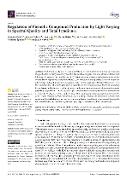Regulation of Phenolic Compound Production by Light Varying in Spectral Quality and Total Irradiance

Autor
Pech, Radomír
Volná, Adriana
Bartas, Martin
Červeň, Jiří
Pečinka, Petr
Špunda, Vladimír
Nezval, Jakub
Datum vydání
2022Publikováno v
International Journal of Molecular SciencesRočník / Číslo vydání
23 (12)ISBN / ISSN
ISSN: 1661-6596Metadata
Zobrazit celý záznamKolekce
Tato publikace má vydavatelskou verzi s DOI 10.3390/ijms23126533
Abstrakt
Photosynthetically active radiation (PAR) is an important environmental cue inducing the production of many secondary metabolites involved in plant oxidative stress avoidance and tolerance. To examine the complex role of PAR irradiance and specific spectral components on the accumulation of phenolic compounds (PheCs), we acclimated spring barley (Hordeum vulgare) to different spectral qualities (white, blue, green, red) at three irradiances (100, 200, 400 µmol m(-2) s(-1)). We confirmed that blue light irradiance is essential for the accumulation of PheCs in secondary barley leaves (in UV-lacking conditions), which underpins the importance of photoreceptor signals (especially cryptochrome). Increasing blue light irradiance most effectively induced the accumulation of B-dihydroxylated flavonoids, probably due to the significantly enhanced expression of the F3'H gene. These changes in PheC metabolism led to a steeper increase in antioxidant activity than epidermal UV-A shielding in leaf extracts containing PheCs. In addition, we examined the possible role of miRNAs in the complex regulation of gene expression related to PheC biosynthesis.
Klíčová slova
antioxidants, flavonoids, HPLC, miRNA, photoprotection, secondary metabolism, spectral quality of light, spring barley (Hordeum vulgare), transcriptomics, UV tolerance
Trvalý odkaz
https://hdl.handle.net/20.500.14178/1978Licence
Licence pro užití plného textu výsledku: Creative Commons Uveďte původ 4.0 International







